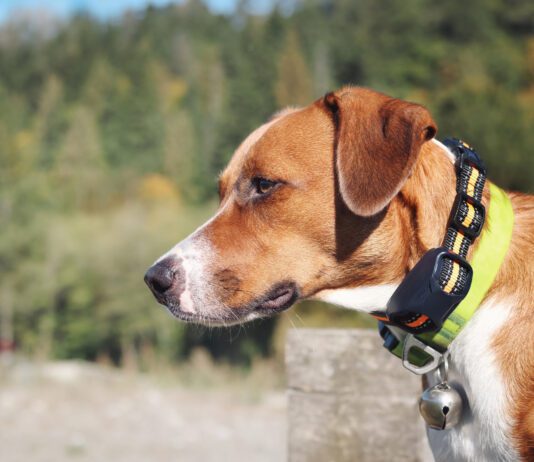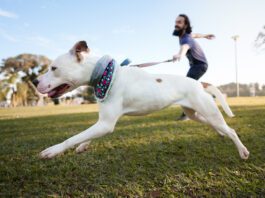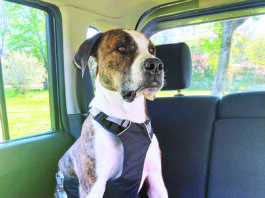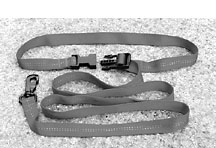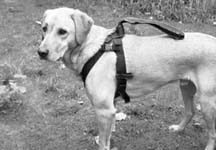The Value of the Harness as a Basic Positive Training Tool
The harness is routinely used for certain canine activities such as carting, mushing, tracking, and guiding the disabled. It is also an important accessory for the canine seat belt, since it’s not safe to restrain your dog by his collar in a moving vehicle. Oddly, there isn’t much talk about the value of the harness as a basic positive training tool. With all the justifiable concern about the risk to a dog’s throat from pressure, or worse, jerks on a collar, it would seem that harnesses might find greater favor with positive trainers.
Proper Identification Tags Can Save Your Dog’s Life
We can never say it often enough or loudly enough – proper identification can save your dog’s life. A dog license is required by law to be worn on your dog’s collar in most places in this country. Owner information from a license can usually be tracked through the local Animal Services agency or Health Department so the lost dog can be returned to his owner if he is picked up by an Animal Services Officer or turned over to an animal shelter by a helpful humanitarian. Obtaining your license in a timely manner can also save you money, since failure to do so can result in citations and fines.
Hands-Free Dog Leashes
With more than 25 years of working with animals professionally under my belt, I don’t find many new product concepts that come as a total and pleasant surprise to me. What a delight, then, to test hands-free leashes for Whole Dog Journal and discover that the best of these products, which started making their appearance in the pet supply retail market in recent years, offer far more than just a convenient way to free up your hands while walking your dog on leash. Few things irritate me more than having a dog constantly tugging on the leash. Thanks to my new doggie daycare center, I now find myself in the position of walking untrained dogs far more frequently than before.
Leading Leashes – Harnesses and Collars for Leash Training
Do you gaze with envy at dogs who walk politely by their owners’ sides, while yours tows you down the sidewalk? Not only is it annoying to have a dog drag you on leash, it can also seriously damage your dog’s trachea and spine. Plus, dogs who strain at their leashes (and who subsequently get jerked by their frustrated handlers) are more likely to have spinal misalignments, and dogs with spinal problems have a much higher incidence of aggressive and/or hyperactive behavior problems.
Car Safety for Canines
There are seat belt laws in most states now, and young children are legally required to be restrained in safety seats in cars in all states. But nowhere is there a law requiring dogs to be safely contained in vehicles. Those that do only address restraint for dogs in the back of open pick-up trucks. (And even when dogs are safely restrained in the back of a truck, the potential for the dog to be severely injured in an accident is great.
No-Slip Dog Collars
No-slip collars are another special-purpose training tool that can be valuable in certain cases. I use only positive reinforcement training methods, and generally don’t allow the use of choke chains in my training classes. But occasionally a student explains that she uses a choke chain because her dog slips out of a regular collar unless it is tightened to the point of the dog’s discomfort. In the interest of helping people who have found themselves in similar circumstances, I tested three collars designed to prevent dogs from slipping away. However, these collars prohibit unlimited choking, making them much more humane options than standard choke collar.
Safest Canine Seat Belts
Your kids always buckle up, and you usually do. It's time to take the next step, and get that dog a seat belt. We'll tell you which one is a winner.
Tethering Your Dog for Training
For many years, I have been a vigorous and vocal opponent of keeping dogs tied or chained as a primary means of confinement. The hazards of tying a dog are well-documented, and include increased aggression, vulerability to human and non-human intruders, and the risk of hanging or choking. It may come as a surprise, therefore, to know that I regard the tether as an invaluable piece of training equipment. The difference and it's a big one is in the application.
Proper Use of Head Halters for Leash Training
Ten years ago, a new dog training tool hit the market. Known generically as the head halter (or head collar), it is a device similar to the halter commonly used on horses. It provides a greatly increased degree of control over the dog who is dedicated to pulling on the collar and leash, without the punishment or pain factors associated with choke chains and prong collars. The head halter has a strap that goes around the dog’s nose, and another that clasps around his neck, just behind the ears. The leash attaches to a ring below the dog’s chin. Just like with halters on horses, bulls and other large animals, it works on the principle that where the nose goes, the body must follow.
Limited Slip Collars: Best for Dog Training and Restraint
We put collars on our dogs for several reasons. Collars give us a convenient place to hang ID tags and licenses very important for a dog's health and safety should he ever get lost. They make a convenient handle when we need to restrain our dog for some reason for safety, training, or to comply with leash laws or social convention. Finally, in some cases, collars are used as training tools, to reinforce cues to a dog; this is a compulsion-based application, not generally used in positive training. In this article, we'e looking at dog collars primarily as a restraint tool, especially as a means to keep our dogs from slip-sliding away.
Much Ado About Muzzles
Let’s be clear about one thing right from the start. A muzzle won’t train your dog. It will not teach your dog to stop biting or chewing, nor will it teach him to love small children, tall men with beards, hats and umbrellas, or your veterinarian. A muzzle is a behavior management tool, properly used as a temporary measure to protect humans (or other dogs) when dogs have to be handled in situations that are too stressful for them to tolerate. A muzzle is also a flashing neon warning sign that it’s time to do some serious counter-conditioning and desensitization so the dog in question can be handled in normal situations without resorting to muzzling.
Dogs Who Are Harness Escape Artists
My dog, Bear, has developed extreme cunning in getting out of whatever device I have on him buckle collar, body harness (two different styles), Halti head halter or any combination of these. The only time he was unable to free himself was when the buckle collar was too tight for safety or comfort. Bear's strategy appears to be to face me, pull backwards, and hop around on his back legs until he pops out of his restraint. Even with the belly band of his harness on tight, he managed to wiggle his elbows through it and pull out backwards.


